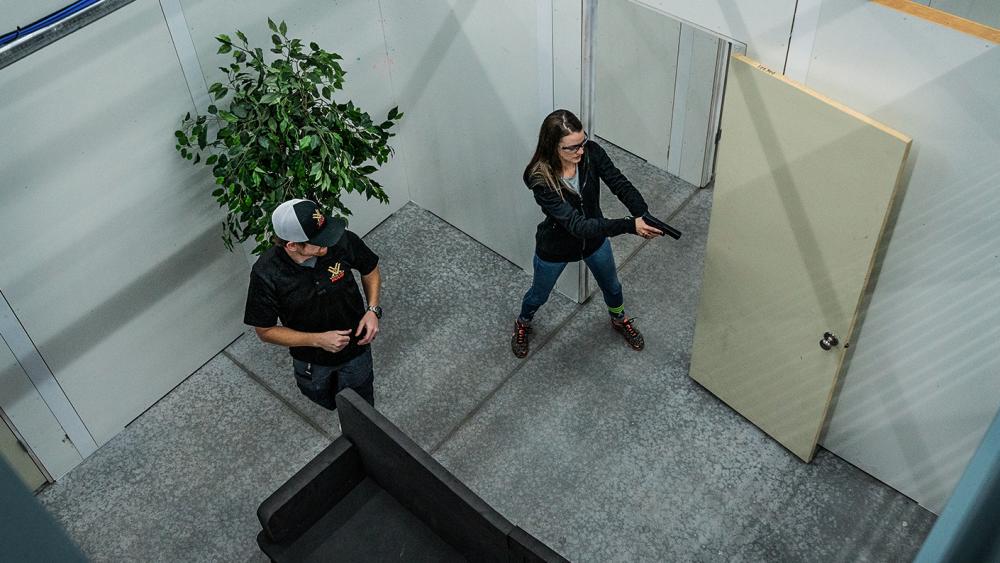5 Home Defense Tips you Need to Know

Defending your home from intrusion is something no one wants to think about. However, it’s a reality that many live with daily. In my experience as a police officer and SWAT operator, I saw first-hand how real these events can be, ranging from unoccupied burglary to forced entry, and more. Here, I will detail a sample CRASH Plan for home defense we share with students who take the Vortex Edge Home Defense course, each step having its own considerations and tips for defending your home and even possibly preventing an intrusion or attack. CRASH is an acronym that stands for:
Confirm
Report
Arm
Secure
Harden
Step 1 – Confirm
This step is twofold for me. I am big on preventing attacks before they happen. This begins by identifying pre-assault indicators such as someone staring at you intently or taking pictures of you and your home. My rule of thumb is if someone is doing anything to make you uncomfortable, report it. The second part of this step is having and using more than one source of intrusion detection systems. Examples of early warning systems can be security camera, exterior motion detection lighting, or pets. Using redundancy can assist you in preparing and requesting emergency services sooner vs being behind in time when an intrusion is happening.
Step 2 – Report
Once you have confirmed that an intrusion is occurring, as early and as safely as possible, dial 911 and put your device on speakerphone. Immediately and clearly state your address and what is going on. If possible, include descriptions of any possible intruders and/or vehicles if your systems allow for collecting this type of information. Using 911 as a means to document what is happening and what you have done to defend yourself can come in handy at a later time.
Step 3 – Arm
Once you have confirmed your home is being broken into and you have started the reporting process, the next step should be to arm yourself. If you keep your home defense firearm secured in a safe, ensure you are practicing and running drills that prepare you to quickly and safely arm yourself. Be mindful of your weapon-mounted or handheld light. If it’s weapon-mounted, are you intimately familiar with how to use it? Do you know where your handheld light is and how to employ it alongside your handgun? I use both and keep them stored in together. I recommend incorporating your full load procedure, including a status check, into your dry fire practice. You have heard firearms safety rule #1 “assume every weapon is loaded”. We teach students to make no assumptions when it comes to the status of a firearm but rather, know the status with absolute certainty. Knowing the load status of the firearms in your home is critical during a high-stress event.
Step 4 – Secure
These are two questions you need to ask yourself during a high-stress situation during the secure phase of your plan. They are:
1- Do I need to move my location, or can I barricade in place?
2- If I need to move to loved ones, can I consolidate everyone and barricade in another room or do I need to move my loved ones to a “hard room”?
A hard room is any room in your home that is easily defendable, ideally has one point of entry, and in which you stage some basic supplies to help you barricade the door. Location of loved ones throughout your home, guests, and locations of entry points to your home should all be taken into consideration when building a response plan. Personally, I will do what it takes to get to my loved ones and have measures in place to barricade in place once I have everyone consolidated. Understand that the movement to a loved one’s room or location is not a room-clearing style of movement; it’s a deliberate movement to secure your people. This may mean that you bypass an entry point as an intruder is attempting entry. For me, locating and consolidating my loved ones takes priority over any property in my home.Step 5 – Harden
You’ve made it to your loved ones, and you have everyone in one defendable space, so you decided to barricade in place. Start to barricade entry doors. I am a big fan of wedge style devices such as the Wedgeit. These act a sturdy delay should someone intend on breaking into your hard room. Once again, I’m a huge believer in redundancy and having complementary delay mechanisms, such as using a piece of furniture in conjunction with a Wedgeit style device. That said, I also want to make sure I’m not giving away my location by dragging a bunch of stuff around.
Lastly, wait for emergency responders to come find you. Give 911 a detailed description of where you are and wait for police to come to you. I hope that you never have to make it to putting a CRASH plan into effect and would much rather you defend yourself by seeing an intrusion coming before it happens. If anything feels or looks out of place, report it. Stay safe.
It’s our hope you can learn and laugh along with the expert voices we feature on this blog. We want to be clear that the opinions you see featured here are just that: opinions. The content belongs to the authors and is not necessarily the opinion of Vortex Optics.
To learn more about what you’ve read, please like, follow, and otherwise support our authors.





